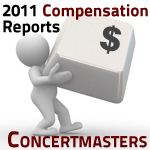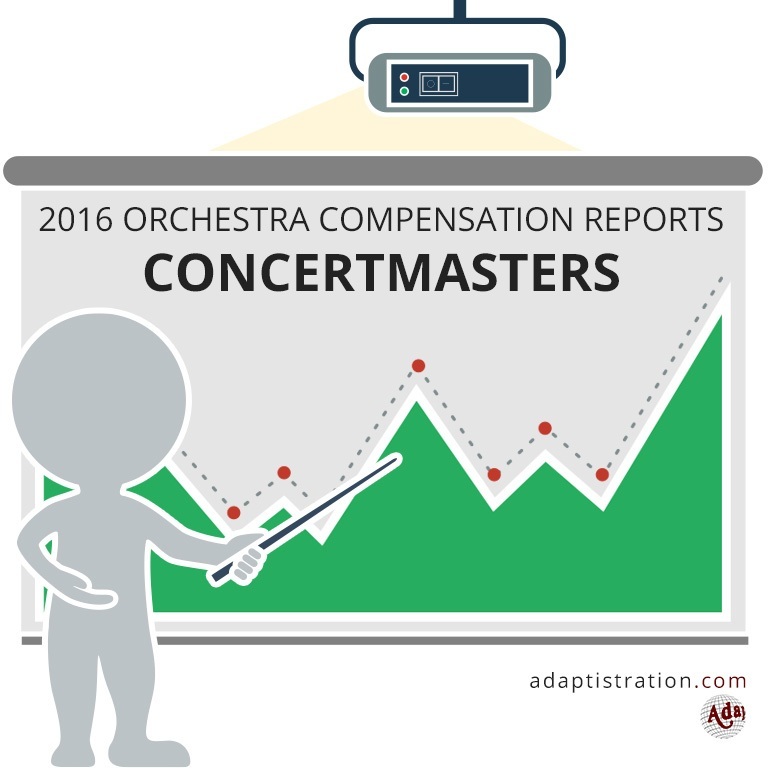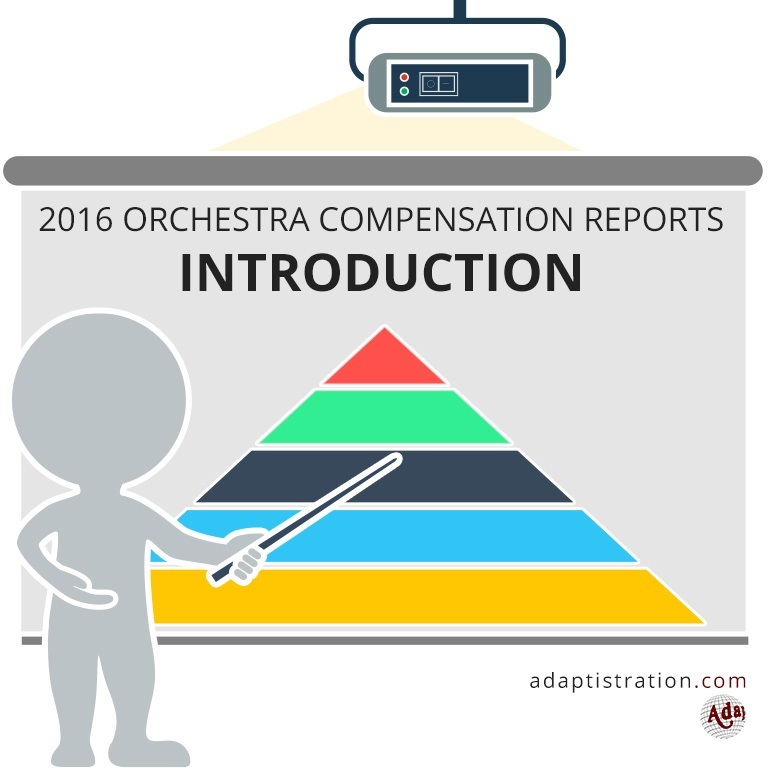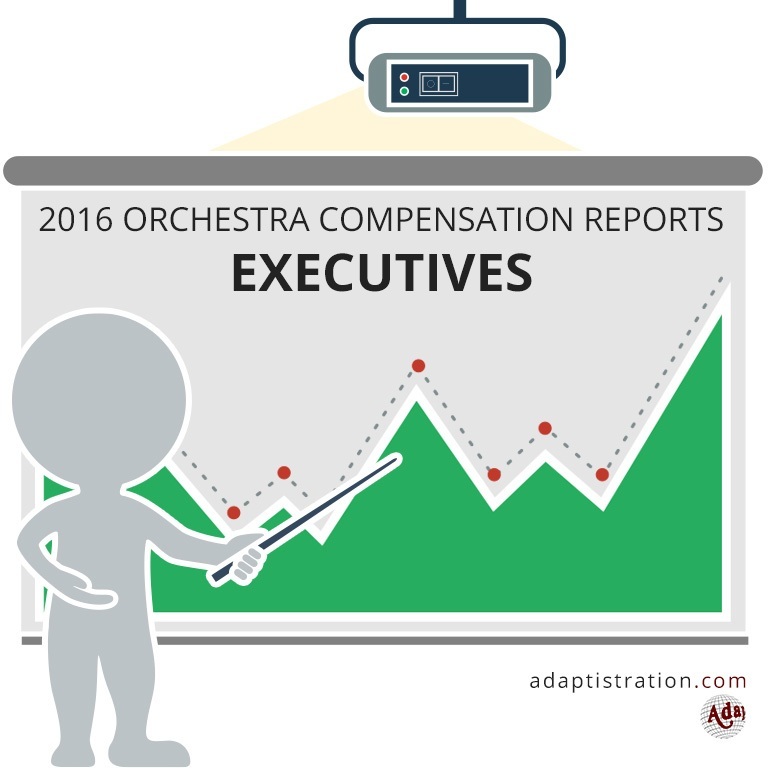The 2008/09 season was an odd year for concertmaster compensation. Changes to the IRS Form 990 practically decimated the number of concertmasters reported (more on that after the break) so determining an average increase/decrease is far from a precise science nor does it represent a comprehensive comparison to previous seasons. Nonetheless, based strictly on the figures that were available, the average concertmaster saw an increase in compensation of 3.65 percent…
An Important Note About Concertmasters in This Year’s Report
 Of the three compensation reports for 2011, the concertmaster report has offered the most adjustments. First and foremost, due to the changes in IRS Form 990, there are fewer concertmaster figures to report. Previously, nonprofit organizations were required to list a fixed number of employees who earned over $50,000/year, but the IRS increased that threshold to $100,000 for the 2008/09 season.
Of the three compensation reports for 2011, the concertmaster report has offered the most adjustments. First and foremost, due to the changes in IRS Form 990, there are fewer concertmaster figures to report. Previously, nonprofit organizations were required to list a fixed number of employees who earned over $50,000/year, but the IRS increased that threshold to $100,000 for the 2008/09 season.
Perhaps unsurprisingly, quite a few concertmasters earning more than $50,000 but less than $100,000 no longer appear on their respective orchestra’s From 990.
As a result, if you don’t see a particular orchestra in the list, it means their concertmaster position was either unfilled for that season or the concertmaster earned less than $100,000 and was therefore not included in the filing. Finally, some concertmasters earning over $100,000 may not be listed because they don’t earn enough to be included in the threshold of maximum employees listed in the 990.
Who Is This Concertmaster Person?
For those not already familiar with the concertmaster position, this is the title reserved for the principal seat within the 1st violin section. More often than not, this is the musician you see walking out on stage at the beginning of the concert to initiate the orchestra’s tuning process before the conductor emerges.
Although concertmasters are included within every orchestra’s collective bargaining agreement, they also negotiate a separate contract with the orchestra detailing compensation and additional duties exclusive to their position. For example, it isn’t uncommon for a concertmaster to be featured as a soloist with the orchestra at least once a year. As such, their annual income will fluctuate based on the number of solo appearances they negotiate with their organization.
Additionally, concertmasters are required to perform any of the numerous internal solos incorporated into any given piece of music (such as the famous violin solo from Scheherazade). Beyond actual performing duties, concertmasters (along with other principal seat string musicians) are usually required to perform additional duties such as Bowings, which are are markings placed throughout a string player’s sheet music that indicate which direction to move the bow. This allows each section of strings to move their bows in unison and enhance to the sense of phrasing a conductor wishes to use.
A common perk associated with many concertmaster individual contracts are clauses excluding them from having to perform during some non-masterwork oriented concerts (such as holiday, pops, or educational concerts). As this clause is not uniform, the frequency and type of concerts concertmasters are excluded from participating vary from one musician to the next. It is also one of the reasons why orchestras may have one or two additional violinists within the orchestra who serve under the title of associate or assistant concertmaster.
Regardless of the additional clauses a concertmaster negotiates in their personal contract, they are afforded the same base workplace protection and representation guaranteed all musicians under the organization’s collective bargaining agreement.
WHERE THE NUMBERS COME FROM
All data presented in these reports coincide with the corresponding documentation from the 2008/09 season. In order to provide information that is as accurate as possible, data for the 2008/09 season is gathered from the following sources:
- Concertmaster compensation figures were obtained from the individual’s respective orchestra’s IRS Form 990.
- Total expenditures were also obtained from each respective orchestra’s IRS Form 990.
- Base Musician compensation figures were obtained from compensation records collected by the American Federation of Musicians (AFM) and the International Guild of Symphonic, Opera, and Ballet Musicians (IGSOBM).
Adaptistration makes no claim to the accuracy of information from documents compiled or reported by external sources. If you have reason to believe any of the information is inaccurate or has changed since reported in any of the above sources and you can provide documentation to such effect, please feel free to send in a notice.
All but a handful of the IRS Form 990’s provided by guidestar.org had a notice indicating that some of the compensation information may not be accurate.
Show the Content
NOTICE
GuideStar has been informed by the IRS of processing errors on IRS Forms 990 filed electronically between January 1, 2009, and December 3, 2010, for form year 2008. These processing errors resulted in inaccurate data appearing on the scanned images of the affected returns that are posted on GuideStar and do not reflect the information filed with the IRS.
These errors include:
- Part III, line 1, organization’s mission description—may not reflect what was originally submitted by the nonprofit organization.
- Part VIII, line 8a, gross income for special events—values may have been transposed.
- Part IX, line 7c, other salaries and wages, management and general expenses—may show a blank where a value was originally reported.
- Schedule D, Part V, line 3a(ii), endowment funds and possession by related organizations— checkbox values may have been transposed.
GuideStar is working with the IRS to obtain a corrected copy of its form year 2008 Form 990. GuideStar will replace this Form 990 if, and when, the accurate return is made available from the IRS. For more information, please visit http://www2.guidestar.org/rxg/help/form-year-2008-returns.aspx
WHAT THE NUMBERS DON’T SHOW
It is important to remember that the numbers shown do not always convey a complete compensation picture. For example, a concertmaster may have had a large increase in salary because they had twice the number of featured solo appearances for this season compared to last. Likewise, they may have left the position after the 2008/09 season and, per terms of their individual contract, received a sizeable severance or deferred compensation package. As such, the cumulative compensation reported under those conditions may artificially inflate or reduce annual earnings.
What the figures don't show for ICSOM Base Musician Figures
What the figures don't show for ROPA Base Musician Figures
As for Regional Orchestra Player Association (ROPA) musicians, unlike the vast majority of their peers in ICSOM ensembles who all earn no less than the musician base salary, all ROPA ensembles use a tiered system of salary and/or per service payments. For example, although an ensemble with a multi-tier system like this may list a base musician salary of $30,000 more than 60 percent of the musicians earn less than that base salary figure. Those players are paid via sliding per service tier system and may earn as little as a few thousand dollars per season.
In the strictly per service ensembles, the figures listed in the Base Musician compensation column are actually the average annual income earned by section string players (or section wind players if no information for the string players was available). This figure is reported by the AFM because it best represents annual earnings for the musicians who perform the greatest number of services in any per service orchestra; string musicians. However, those compensation figures are not always guaranteed. Additionally, the Base Musician figures do not include any additional payments offered by some organizations such as voluntary outreach services, and minimum overscale payments. Finally, opera or ballet organizations are not included in these reports, only symphonic and chamber orchestra ensembles.
TOP 10 EARNERS
- New York Philharmonic:$530,153
- Cleveland Orchestra: $489,376
- San Francisco Symphony: $464,704
- Atlanta Symphony: $447,798
- Chicago Symphony: $441,487
- Los Angeles Philharmonic: $435,298
- Boston Symphony: $434,456
- Philadelphia Orchestra: $402,561
- Pittsburgh Symphony: $374,982
- Baltimore Symphony: $307,822




Can you advise where I’d find the annual compensation report for choral directors. I’m writing you from Santa Cruz, CA and our Temple choral director is being paid by the service which includes 2 – 2 hr rehearsals, 1 – 45 min dress rehearsal and then the service. Where might I get an idea if what she is being paid is within the realm of reasonable? Many thanks!
Hi Sandra, I’m not aware of a compensation report for choral directors like what is availalbe here via the orchestra compensation reports. Short of compiling the information yourself from IRS Form 990’s availalbe at sources like guidestar.org (which is a free resource), I would recommend hiring a consultant; which in full disclosure, is precisely what I do for a living: http://www.orchestraconsulting.com/.